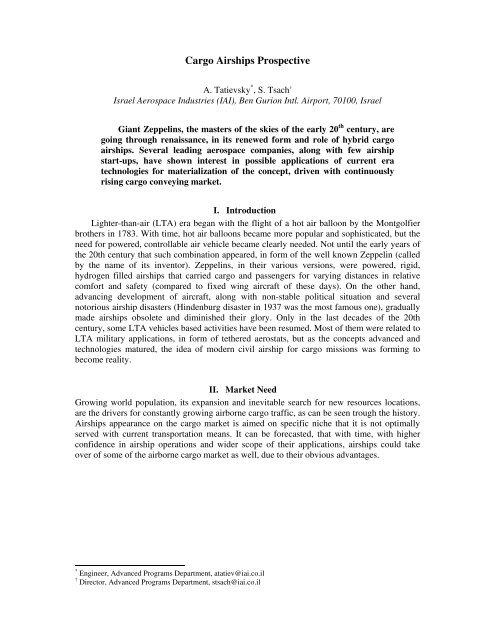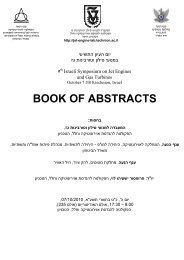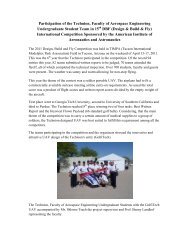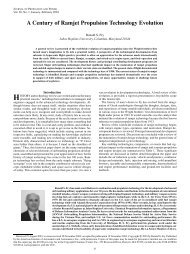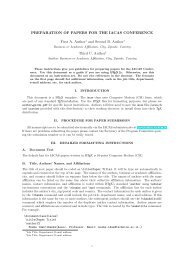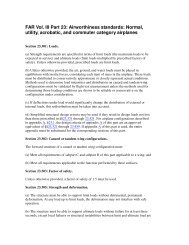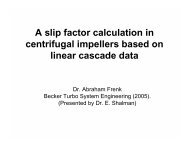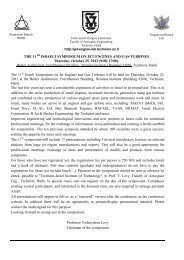Cargo Airships Prospective - Faculty of Aerospace Engineering
Cargo Airships Prospective - Faculty of Aerospace Engineering
Cargo Airships Prospective - Faculty of Aerospace Engineering
You also want an ePaper? Increase the reach of your titles
YUMPU automatically turns print PDFs into web optimized ePapers that Google loves.
<strong>Cargo</strong> <strong>Airships</strong> <strong>Prospective</strong><br />
A. Tatievsky * , S. Tsach †<br />
Israel <strong>Aerospace</strong> Industries (IAI), Ben Gurion Intl. Airport, 70100, Israel<br />
Giant Zeppelins, the masters <strong>of</strong> the skies <strong>of</strong> the early 20 th century, are<br />
going through renaissance, in its renewed form and role <strong>of</strong> hybrid cargo<br />
airships. Several leading aerospace companies, along with few airship<br />
start-ups, have shown interest in possible applications <strong>of</strong> current era<br />
technologies for materialization <strong>of</strong> the concept, driven with continuously<br />
rising cargo conveying market.<br />
I. Introduction<br />
Lighter-than-air (LTA) era began with the flight <strong>of</strong> a hot air balloon by the Montgolfier<br />
brothers in 1783. With time, hot air balloons became more popular and sophisticated, but the<br />
need for powered, controllable air vehicle became clearly needed. Not until the early years <strong>of</strong><br />
the 20th century that such combination appeared, in form <strong>of</strong> the well known Zeppelin (called<br />
by the name <strong>of</strong> its inventor). Zeppelins, in their various versions, were powered, rigid,<br />
hydrogen filled airships that carried cargo and passengers for varying distances in relative<br />
comfort and safety (compared to fixed wing aircraft <strong>of</strong> these days). On the other hand,<br />
advancing development <strong>of</strong> aircraft, along with non-stable political situation and several<br />
notorious airship disasters (Hindenburg disaster in 1937 was the most famous one), gradually<br />
made airships obsolete and diminished their glory. Only in the last decades <strong>of</strong> the 20th<br />
century, some LTA vehicles based activities have been resumed. Most <strong>of</strong> them were related to<br />
LTA military applications, in form <strong>of</strong> tethered aerostats, but as the concepts advanced and<br />
technologies matured, the idea <strong>of</strong> modern civil airship for cargo missions was forming to<br />
become reality.<br />
II. Market Need<br />
Growing world population, its expansion and inevitable search for new resources locations,<br />
are the drivers for constantly growing airborne cargo traffic, as can be seen trough the history.<br />
<strong>Airships</strong> appearance on the cargo market is aimed on specific niche that it is not optimally<br />
served with current transportation means. It can be forecasted, that with time, with higher<br />
confidence in airship operations and wider scope <strong>of</strong> their applications, airships could take<br />
over <strong>of</strong> some <strong>of</strong> the airborne cargo market as well, due to their obvious advantages.<br />
* Engineer, Advanced Programs Department, atatiev@iai.co.il<br />
† Director, Advanced Programs Department, stsach@iai.co.il
Figure 1. World Air <strong>Cargo</strong> Traffic Forecast (Boeing World Air <strong>Cargo</strong> Forecast 2010-2011) [1] . World's<br />
constantly growing GDP and population over the last century, assures constantly growing need for cargo<br />
transportation.<br />
Many remote communities, oil platforms and wind turbine sites are served today with non<br />
reliable network <strong>of</strong> ground transportation or with very expensive airborne means. Process <strong>of</strong><br />
transferring the needed equipment, supplies and commodities to the site, in the needed<br />
quantities, can take therefore several days or even weeks and cost a fortune. Roads and rail<br />
cannot be easily constructed, due to huge cost <strong>of</strong> transport network establishment in the<br />
remote areas, because <strong>of</strong> topographical and weather limitations, or just because <strong>of</strong> insufficient<br />
financial justification for such endeavor. Airstrip or a heliport at the site is a plausible option<br />
in most cases, but due to high operational cost <strong>of</strong> aircraft and relatively small payload volume<br />
they can take, it is not the best solution for large cargo hauling. This is the playground for the<br />
cargo airship. While it is much slower than conventional fixed wing aircraft, airship can carry<br />
the same payload for a fraction <strong>of</strong> the cost and can be designed to operate without any special<br />
infrastructure in the delivery site. It is closer by operational costs to ground vehicles, but<br />
unlike them, it's not restricted by terrain obstacles and lacks the need <strong>of</strong> roads and rails.<br />
Airship can be designed in such way, that the cargo would be underslung beneath its gondola,<br />
allowing it to transport oversized payloads in one piece (for example wind turbine blade), to<br />
inaccessible and remote location, thus simplifying the logistics and allowing high cost<br />
reduction. Insufficient ground transportation network, in developing areas or in countries with<br />
large territories, could benefit from airship type <strong>of</strong> transportation as well.<br />
Figure 2. Airship could be very much handy in such cases
Hybrid cargo airship operational costs, place the airship in its own niche <strong>of</strong> the market,<br />
somewhere between ground and sea transportation to aircraft options. UK based Hybrid Air<br />
Vehicles (HAV) company, has estimated cargo operational cost somewhere between 0.2-1.4<br />
[$*ton/km] (the larger the airship, the lesser the cost), while seaborne cargo vessels cost is<br />
around 0.08 [$*ton/km] (although this value can vary depending on supply & demand) and<br />
finally the fixed-wing aircraft costs are in the range <strong>of</strong> 10-30 [$*ton/km].<br />
Figure 3. <strong>Cargo</strong> transportation market niches classification [2] . Please note, that the future hybrid cargo<br />
airships type, fills the gap between existing ground and airborne means <strong>of</strong> transportation.<br />
III. What a Hybrid Airship is?<br />
First it is important to understand what an airship actually is and how it works. Airship can<br />
differ in size, internal structure concept and even its operational concept. Modern designs <strong>of</strong><br />
cargo airship use the same basic principles as zeppelins, albeit in the same time they are much<br />
different. Understanding the airship concept is essential for understanding the potential that<br />
modern cargo airships can have in the cargo market.<br />
Airship is in fact a non-permeable bag, filled with lighter-than-air gas (which density is lower<br />
than surrounding atmosphere), powered and steerable. It uses, usually, several sources for<br />
achieving lift and has several different structural approaches, who defines its nature. In the<br />
next two paragraphs, we will try to explain its main operational and structural principles, to<br />
shed some light <strong>of</strong> this long forgotten, but promising type <strong>of</strong> transportation.<br />
A. Operational Concept<br />
Modern cargo airship design configurations mainly appear as an advanced semi-rigid<br />
structure airship, in so-called "hybrid" multi-sourced-lift form configuration; filled with<br />
lighter-than-air, non-flammable helium gas. Its lift achieved mainly by buoyancy <strong>of</strong> helium,<br />
but in part by aerodynamic lift as well, created by an airflow over its hull. The aerodynamic<br />
lift, achieved due to movement <strong>of</strong> the lifting-body-shaped hull or by purpose built wings,<br />
attached to the hull or by any combination <strong>of</strong> the above. Additional common ways <strong>of</strong> creating<br />
lift in airship is by tilting its engines vertically, or by dedicated rotors that are designed to<br />
create thrust to overcome some <strong>of</strong> the weight, as it happens in rotorcraft designs. Hybrid<br />
design concept therefore, stands for achieving the total lift force from several sources and by<br />
this contributing to a smaller overall size for a given payload, compared to conventional cigar-
shaped airships. Achieving smaller size <strong>of</strong> the airship is pretty much wanted, because it<br />
affects directly the needed size <strong>of</strong> the infrastructure, namely the hangar.<br />
Figure 4. Hybrid airship three sources <strong>of</strong> lift – Aerostatic, Vectored thrust and Aerodynamic lifts (Hybrid<br />
Air Vehicles (HAV) website)<br />
An important feature, found typically in non-rigid or semi-rigid airships, is the ballonets.<br />
When the airship change its altitude, the most important factor influencing it, is the<br />
differential between the lifting gas density, inside the airship, to the density <strong>of</strong> the ambient<br />
atmosphere. This way, when the airship climbs, the lifting gas inside it expands, activating<br />
pressure on its envelope. In order to avoid such condition (due to heavy penalty induced on<br />
the weight <strong>of</strong> the envelope material capable <strong>of</strong> withstanding higher than atmospheric<br />
pressures), ballonets are used. Ballonets are in fact non-permeable pockets inside the airship,<br />
designed to be filled with outside air. When the airship rises, and the lifting gas expands,<br />
occupying more volume inside and reducing its density, the air flows out <strong>of</strong> these pockets,<br />
allowing to keep the airship's hull form and same internal pressure over all extent <strong>of</strong> flight.<br />
When the airship reaches the height, in which the ballonets are fully deflated, it is called<br />
airship's pressure height and it is usually the maximum designed height the airship allowed to<br />
reach. In the emergency case that the airship rises beyond this limit, due to weather conditions<br />
or direct sunlight, emergency procedures are usually implemented, by releasing some <strong>of</strong> the<br />
lifting gas in order to relieve pressure and descend. Pressure height can be designed, by<br />
allocating enough volume for the maximum expansion <strong>of</strong> the ballonets and filling the airship<br />
with specific amount <strong>of</strong> lifting gas. For example, for airship designed for pressure height <strong>of</strong><br />
10,000 ft in normal ISA conditions (typical pressure height value for most <strong>of</strong> the modern<br />
cargo airship designs), it is needed to allow about one quarter <strong>of</strong> its volume to the maximum<br />
expansion <strong>of</strong> the ballonets at the sea level (SL) (where the atmosphere pressure is the highest).<br />
This way, the higher the designed height pressure altitude would be chosen, the higher lifting<br />
gas volume for given payload will need to be assigned (larger airship).
Figure 5. Ballonets at Take<strong>of</strong>f, Climb, and Pressure Height – System for equalizing inside pressure in<br />
order to maintain airship shape, used mainly in non-rigid and semi-rigid airships [3]<br />
More complicated are the ascent / descent procedures <strong>of</strong> an airship. It can be achieved by<br />
several means. In hybrid airships, with some <strong>of</strong> the total lift achieved due to aerodynamic<br />
properties (about 30% <strong>of</strong> the total lift), varying the airspeed alone can achieve the required<br />
change in lift. Additionally, pitching the hull nose-down can reduce the lift or even reverse its<br />
direction, in order to descend, and vice-versa for ascending. Thrust vectoring, allowing usage<br />
<strong>of</strong> force in the needed direction, used as well. Thus, usually several methods are used<br />
concurrently, in order to achieve desired result. Due to its buoyant nature and relatively low<br />
cruise speed, the reaction <strong>of</strong> the airship to a force application is rather slow, so there is need to<br />
allow for slow and continues response <strong>of</strong> the complicated system architecture for changing the<br />
airships height (it applies for more methodical piloting). It is worth to mention that the<br />
airships usually fly in neutral or heavier-than-air conditions (supplementing the additionally<br />
needed lift by other means than buoyancy, as mentioned), in order to have easier height<br />
control.<br />
Another way, used in the past, for controlling height and weight <strong>of</strong> the airship, is by<br />
extracting water from engines emissions (suitable mostly to internal combustion engines), to<br />
compensate for fuel weight loss. Proposed additional methods include air compression or<br />
lifting gas compression for weight control, or lifting gas heating for increased buoyancy, but<br />
each method has to be well considered for its trade-<strong>of</strong>fs.<br />
B. Airship Structure<br />
Along with airship classification by its lifting sources, another sorting is by its internal<br />
structure. There are three distinct types <strong>of</strong> LTA vehicles configurations: rigid, semi-rigid and<br />
non-rigid. Non-rigid airship, usually called "blimp", is actually an inflated powered balloon,<br />
in which the cigar-shaped form is created by a small over-pressure <strong>of</strong> the lifting gas. As<br />
previously mentioned; in order to keep its form in-flight, a rather complex system <strong>of</strong> internal<br />
air bags, called ballonets, inflate and deflate, using the surrounding air, in the objective <strong>of</strong><br />
maintaining internal pressure constant in various altitudes and temperature conditions. There<br />
is no load bearing internal structure in a blimp; the gondola, tails and engines connected<br />
directly to the hulls skin. Hull's shape maintained and loads distributed by material local<br />
patches, coupled with internal cable system (catenary curtain). This configuration allows
significant structure weight reduction, but on the same time, does not allow high loads;<br />
literally only slow cruise speed and small payload is allowed. Thus blimps are usually the<br />
smallest in the variety <strong>of</strong> airships, and used mainly for purposes <strong>of</strong> local surveillance, airborne<br />
advertising and as a small tour vehicle. Fully rigid airships, as were the giant zeppelins <strong>of</strong> the<br />
past, are at the opposite side <strong>of</strong> scale. They have full internal framework that is not only<br />
intended for the loads but for keeping the external form as well. This makes ballonet system<br />
unnecessary to some point, but on the other hand, increases vastly the structure weight, on the<br />
expense <strong>of</strong> the potential useful load. Semi-rigid airships are basically a trade-<strong>of</strong>f option<br />
between the two. It is similar to non-rigid ones, with the difference <strong>of</strong> owing some sort <strong>of</strong><br />
load-bearing internal structure; by this achieving higher load tenability, with reasonable<br />
penalty <strong>of</strong> the additional weight. Progress in the field <strong>of</strong> the building materials, as will be<br />
presented in the next paragraph, has allowed building stronger and tougher semi-rigid<br />
airships, thus making them a preferred option. While not utterly disbanded, rigid airship<br />
designs are rare nowadays and most <strong>of</strong> the current designs are based on semi-rigid hulls for<br />
cargo airships and non-rigid for lighter applications.<br />
Figure 6. Three examples <strong>of</strong> main airship structure types presented. From left to right: Goodyear nonrigid<br />
blimp, Zeppelin NT semi-rigid airship and USS Shenandoah rigid zeppelin.<br />
IV. Technologies<br />
History <strong>of</strong> flight is fully bound with the technological progress. New technology<br />
development, has allowed incremental improvement <strong>of</strong> the flight vehicles, beyond the<br />
previously known frontiers. Same principle is relevant for all types <strong>of</strong> aircraft and for lighterthan-air<br />
vehicles as well. The evolution <strong>of</strong> advanced designs and its competitive advantages<br />
(compared to the past), took place mostly because <strong>of</strong> technological progress in materials,<br />
avionics, systems and propulsion.<br />
With no doubt, one <strong>of</strong> the greatest progress advances in airship technology was made in<br />
the areas <strong>of</strong> structure and materials. Massive metal internal structure was substituted by<br />
lightweight and strong composite framework. Implementing aircraft based experience on<br />
composites, lead to building much lighter gondola, engine nacelles and systems casing.<br />
Polymer based, multi-layered, impervious and durable envelope material took place <strong>of</strong> former<br />
heavier and more permeable fabrics <strong>of</strong> the airship's envelope. Zeppelin's skin was usually<br />
made from heavy cotton fabric, which was soaked with rubberized coating and externally<br />
laminated with aluminum coating for better weathering durability. The lifting gas was stored<br />
inside it, in separate gas cells, made from intestines <strong>of</strong> cattle and goats. Contemporary<br />
airship's skin is usually made <strong>of</strong> at least three layers – load bearing layer made <strong>of</strong> tough<br />
material (like Kevlar or Vectran), non-permeable layer made <strong>of</strong> Mylar and additional polymer<br />
coating (like Tedlar), for increased imperviability and weathering resistance. The results <strong>of</strong><br />
improving envelope materials are; lesser weight, better lifting gas sealing and higher<br />
structural strength. Constantly improving synthetic and fiber materials development and
manufacturing processes, allows assuming further empty to total weight ratio reduction. This<br />
is the main reason why most <strong>of</strong> the present cargo airship projects, presents concepts <strong>of</strong> semirigid<br />
airship, as a default.<br />
Fly-by-wire (FBW) controls for engines and control surfaces, coupled with advanced avionics<br />
and systems enhance stability and control, as well as navigation. Large size <strong>of</strong> the airship's<br />
hull, derived from its nature, require the use <strong>of</strong> fly-by-wire system much more than in fixed<br />
wing aircraft. FBW can contribute for a weight saving <strong>of</strong> airship's systems, which is an<br />
important feature in a platform, where each kilogram counts. FBW, coupled with specialized<br />
computerized avionics system, simplifies control and navigation <strong>of</strong> an airship. As the airship<br />
is more susceptible to gusts, compared to fixed wing aircraft, due to its large cross-section, an<br />
active control system is required.<br />
Finally, airships today use smaller, more powerful but more fuel efficient internal combustion<br />
engines than before. In the early days <strong>of</strong> aviation, Zeppelins used the available aero-engines,<br />
which were heavy, bulky and weak. Over the time, engines <strong>of</strong> internal combustion developed<br />
further and turbojets were invented. Turbojet invention led to creation <strong>of</strong> the turboprop<br />
engines, which are most suitable for cargo airships, due to its power requirements. Turboprop<br />
engines are usually smaller than comparably powered internal combustion engines, but they<br />
are slightly less efficient. In recent years, due to environmental and regulation policies<br />
tendency, there is a trend to plan future projects, towards hybrid or even fully electrical<br />
propulsion, with integrated solar panels on the airship's hull.<br />
Figure 7. Several <strong>of</strong> the key technologies that make airship fly<br />
V. Challenges and Opportunities<br />
Along with their great potential, airships do have several inherent disadvantages.<br />
Compared to aircraft they are more limited in bad weather operations; due to their large size<br />
they are more susceptible to winds and precipitations. Their buoyancy is affected by direct<br />
sunlight and surrounding air density and temperature. <strong>Cargo</strong> airships are generally restricted<br />
to operations under 10,000ft, due to increasing typical wind speed pr<strong>of</strong>ile and decreasing air
density (reduces buoyancy lift), changing with altitude. For maintenance, manufacturing and<br />
long term storage, huge hangars are needed; and mooring devices are used in order to anchor<br />
airships to the ground for parking and maintenance. Finally, current most applicative lifting<br />
gas is the inert helium, which is solely found in relatively small quantities in some natural gas<br />
reservoirs, and thus is relatively expensive and scarce.<br />
The good news is that new technologies and designs have good chance to overcome most<br />
<strong>of</strong> the deficiencies. Modern technologies <strong>of</strong>fer much improved control in various conditions,<br />
weather prediction has improved drastically and hybrid airship design introduce much more<br />
autonomous ground operation flexibility than before, along with better stability in-flight. New<br />
technologies and their anticipated future development, allows us to predict that their<br />
implementation in the airship design will allow cost-effective and reliable service <strong>of</strong> the air<br />
vehicle in diverse environmental conditions. Reduced infrastructure needs, with higher<br />
autonomy <strong>of</strong> the hybrid airship, would allow it to operate in areas with no suitable facilities.<br />
Helium forecasted to remain high priced, but with well planned operational use <strong>of</strong> the airship<br />
and execution <strong>of</strong> required maintenance schedule, its annual consumption will be negligible.<br />
Figure 8. Typical Wind Pr<strong>of</strong>ile at Mid-Latitude Areas<br />
VI. Airship Related World Activities<br />
Rising cargo market demand, new applicable technologies, environmental issues<br />
importance increase and military LTA successful applications, make a favorite environment<br />
for new development <strong>of</strong> cargo airships. Few more or less successful projects appeared in<br />
recent years; both in military and civil sectors <strong>of</strong> the market. Large corporations, along with<br />
several aerospace "start-ups" have realized the market potential <strong>of</strong> lighter-than-air<br />
transportation. Few <strong>of</strong> them are newcomers to this renovated idea, but some have a long<br />
history <strong>of</strong> dealing with lighter-than-air application; usually with aerostats, as in case <strong>of</strong><br />
Lockheed Martin. Now they all race with a common goal – who will be the first to release the<br />
long promised new generation <strong>of</strong> cargo airship.<br />
Lockheed Martin is one <strong>of</strong> the main leaders in this area. Lockheed Martin develops the<br />
SkyTug cargo airship, with further increment designs in the future, after flying P791 hybrid<br />
airship demonstrator in 2006. P791 is so far, the first known hybrid airship flown and was<br />
intended for testing and gaining experience for transition to truly operational cargo airship,<br />
the one that SkyTug intends to be. SkyTug intended for the low tier <strong>of</strong> cargo airship market,<br />
with proposed design point <strong>of</strong> 20 tons payload and length <strong>of</strong> 88 m and entry to service as early<br />
as 2013. Aviation Capital Enterprises, a Canadian based investment company has joined
Lockheed for this project, and forecast a market for 300 airship. In the future, Lockheed plans<br />
to increase its airship lineup towards larger airships, which would allow lifting heavier loads.<br />
Another large military company, Northrop Grumman, joined UK hybrid airship venture<br />
named Hybrid Air Vehicles (HAV), to develop the hybrid Long Endurance Multi-intelligent<br />
Vehicle (LEMV) for the US DoD (Department <strong>of</strong> Defense). It has received funding <strong>of</strong> 517M$<br />
for this project and according to recent publications, it is in final stages <strong>of</strong> developing <strong>of</strong> its<br />
hybrid airship for an operational service. It is planned to have a cargo derivative, capable <strong>of</strong><br />
lifting <strong>of</strong> about 20 tons. In parallel, HAV works on its own family <strong>of</strong> cargo airships, with<br />
lifting capabilities from 20 to 200 tones. It was recently published that HAV has closed a<br />
preliminary deal with Discovery Air Innovation, a Canadian aviation company, for selling a<br />
fleet <strong>of</strong> its 50 ton variant airship, the HAV366 (entry to service in 2014), intended for the<br />
local mining and natural resources market.<br />
Aeros, a LTA US based manufacturer, is currently one <strong>of</strong> the few pursuing the large<br />
airship market, with rigid airship designs, named Aeroscraft and Pelican. Aeroscraft airship<br />
intended for civil market (passengers and cargo), while Pelican airship, taking form nowadays<br />
at the company’s hangar, is funded by DARPA for 50M$ and intended to be a demonstrator<br />
for a future 60 ton payload cargo carrier.<br />
More notable projects in this market have taken place;<br />
Ohio <strong>Airships</strong>, an airship "start-up", has designed its cargo Dynalifter family, along<br />
with an ISR unmanned derivative. Small prototype flown in 2010. The proposed hybrid<br />
airship design included conventional hull with several wings for increased<br />
aerodynamic lift.<br />
Boeing developed for several years a conceptual rotorcraft airship, named Skyhook, for<br />
transporting oversized payloads. Some <strong>of</strong> its lift came from four large rotors, located<br />
on the gondola installation.<br />
<strong>Cargo</strong>Lifter AG was a German company, established in 1996 for creating a CL160<br />
cargo airship (conventional configuration). After building a remarkable airship hangar<br />
and a small manned prototype, the company announced insolvency in 2002.<br />
Augur RosAeroSystems Russian LTA company, proposed ATLANT, a concept for a<br />
family <strong>of</strong> rigid hybrid cargo airships.<br />
Today there is no operational cargo airship yet, but already in the next year we're expected to<br />
witness cargo airship demonstrator floating in the skies.<br />
Figure 9. Several <strong>of</strong> the proposed cargo airships, showing the potential mission applications<br />
Few military ISR airship projects are in the works today as well. Because <strong>of</strong> the short scope <strong>of</strong><br />
this article, we'll just mention them by name: conventional MAV6 Blue Devil II, stratospheric<br />
high-altitude Lockheed Martin ISIS & HAA and the previously mentioned Northrop<br />
Grumman / HAV LEMV hybrid airship.
Figure 10. Leading airship projects in US in recent years. Images at the bottom are for scale. [4]<br />
VII. IAI <strong>Cargo</strong> Airship Activity<br />
Israel <strong>Aerospace</strong> Industries Ltd. (IAI) is a prominent worldwide leader in wide scope <strong>of</strong><br />
aerospace market sectors, from unmanned aviation through business aircraft and satellites. It<br />
has been involved in R&D <strong>of</strong> the LTA market as well. Recently a study for potential cargo<br />
airship application has been initiated. Several potential configurations are being studied, along<br />
with applicable market and technologies research. IAI evaluates a family <strong>of</strong> advanced hybrid<br />
cargo airships, starting with Caspion 20 (20 ton payload airship) and continuing to the larger<br />
segment, with Caspion 200 (200 ton payload airship). Caspion airships family is designed to<br />
incorporate advanced technologies in structure and systems, VTOL (Vertical Take-Off &<br />
Landing) capability and <strong>of</strong>fer the competitive edge compared to other means <strong>of</strong> transportation<br />
and other cargo airship projects. Caspion airships will present high autonomous operation,<br />
with improved availability and reliability in all weather conditions.<br />
Preliminary parameters <strong>of</strong> the Caspion 20 hybrid cargo airship:<br />
Payload: 20 tons<br />
Range: 2,500 nm<br />
Max. Cruise Speed: 100 kts<br />
Figure 11. IAI Caspion 20 - potential configurations for hybrid cargo airship
VIII. Conclusion<br />
In our constantly developing and growing world, new boundaries are to be broken and<br />
new goals are to be achieved. Some <strong>of</strong> the progress dependant on improving and refining the<br />
best <strong>of</strong> the technologies invented. Hybrid cargo airship is <strong>of</strong>fering these opportunities,<br />
allowing achieving capabilities never achievable before. It is an efficient air vehicle, tailorsuited<br />
to meet the challenges <strong>of</strong> carrying over-sized goods to hard reachable locations and can<br />
be beneficial in many other transportation mission pr<strong>of</strong>iles. Its technologies are within reach<br />
nowadays and <strong>of</strong>fer substantial improvement over the past generations <strong>of</strong> LTA vehicles. This<br />
opens the way for utterly realistic implementation <strong>of</strong> such endeavor and can be seen in<br />
growing revival <strong>of</strong> interest for airships in many commercial companies worldwide. IAI as one<br />
<strong>of</strong> the most notable leaders <strong>of</strong> the aerospace industry has joined this area <strong>of</strong> interest and is<br />
investing in research for creating viable and competitive hybrid airship for cargo.<br />
While some may dispute some <strong>of</strong> its operational limitation, there is no doubt: it is a new dawn<br />
for giant cargo airships.<br />
List <strong>of</strong> Abbreviations<br />
DARPA – Defense Advanced Research Projects Agency (US)<br />
DoD – Department <strong>of</strong> Defense (US)<br />
FBW - Fly-By-Wire<br />
GDP – Gross Domestic Product<br />
HAA – High Altitude Airship<br />
HAV - Hybrid Air Vehicles (UK)<br />
IAI – Israel <strong>Aerospace</strong> Industries<br />
ISA – International Standard Atmosphere<br />
ISIS – Integrated Sensor Is Structure<br />
ISR – Intelligence Surveillance and Reconnaissance<br />
LEMV - Long Endurance Multi-intelligent Vehicle<br />
LTA – Lighter Than Air<br />
nm – nautical miles<br />
SL – Sea Level<br />
References<br />
1. Boeing World Air <strong>Cargo</strong> Forecast Team, "Boeing World Air <strong>Cargo</strong> Forecast 2010-2011",<br />
Boeing Commercial Airplanes, Feb. 2011, p. 8<br />
2. Barry A.King II, Major, "Hybrid <strong>Airships</strong>: Well Suited for Foreign Humanitarian<br />
Assistance Operations", Air University, Maxwell Air Force Base, USAF, March 2011,<br />
p.18<br />
3. Colonel Walter O. Gordon, Colonel Chuck Holland, "Logistics History – Back to the<br />
future: <strong>Airships</strong> and the Coming Revolution in Strategic Airlift", USAFR, Air Force<br />
Journal <strong>of</strong> Logistics, Volume XXIX, Number 3/4, p. 51<br />
4. Alec Johnson, "Recent Development Efforts for Military <strong>Airships</strong>", Congressional<br />
Budget Office, US, Pub. No. 4239, Nov. 2011, p.6<br />
5. Gabriel A.Khoury and J. David Gillett “Airship Technology,” Cambridge <strong>Aerospace</strong><br />
Series 10, Cambridge University Press, Cambridge, UK, 1999<br />
6. Raffael György, Klaus Broichhausen, Jost Seifert "Potentials <strong>of</strong> Lighter-Than-Air<br />
Technology in Future Markets – an Evaluation", Bauhaus Luftfahrt e.V., ICAS 2008 26 th


